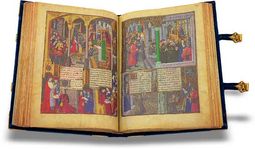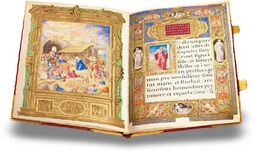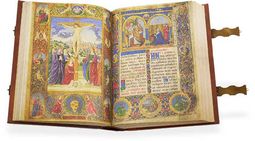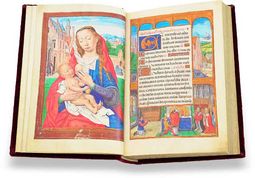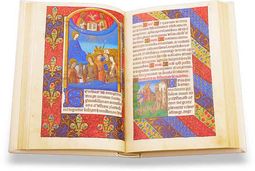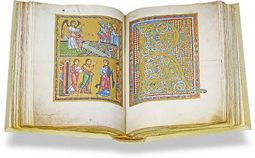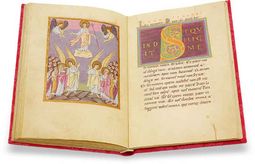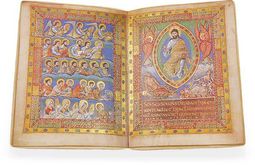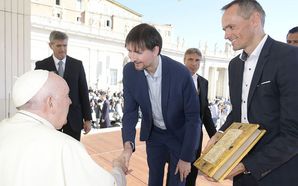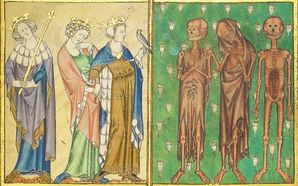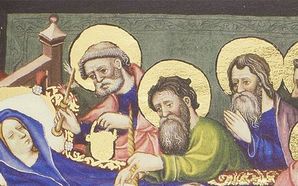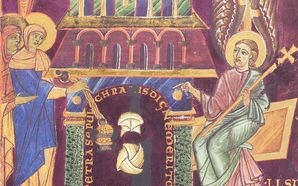The Communion of Saints in Heavenly Spheres: All Saints' Day in Medieval Book Illumination
When we think of All Saints' Day, many probably have associations with cemeteries shrouded in mist, countless candles and wreaths, and also processions in their minds. The iconography that emerged in the Middle Ages, on the other hand, shows what is not visible on earth and opens up a glimpse into heavenly spheres where the saints are already united with God and have reached the state of eternal bliss. But how are "all the saints" brought into a single image? This artistic task held challenges especially for book illumination, since the subject often had to be realized in the smallest of spaces. In the following article, we would like to give an impression of the diverse and elaborate solutions in book art with which medieval illuminators set the foundation for the monumental All Saints' images on large canvases and in impressive ceiling frescoes. However, let us begin with an overview of the origin and meaning of this holiday.

To the facsimile
All Saints' Day: Memorial Day and Solemnity
As the name suggests, on All Saints' Day all Christian saints are memorialized through prayers and intercessions. This includes not only those who have been officially canonized by the Pope, such as the wheeled martyr Catherine of Alexandria or the French King Louis the Saint, but also those who quietly and consistently lived a life in the spirit of the Christian faith. They all, according to faith, ascended directly to heaven to enjoy their eternal life in the blessed communion with God in heaven or paradise. In both the Orthodox and Catholic Churches, the feast day has the status of a Solemnity, which underscores the importance of the commemoration of the saints.

To the facsimile
The Lord's Day of All Saints

To the facsimile
The origins of All Saints' Day can be traced back to the 4th century. Already at that time, a Solemnity in honor of all martyrs who had no memorial day of their own was introduced in the Eastern Church on the first Sunday after Pentecost, from which the Lord's Day of All Saints was established. The preacher and archbishop of Constantinople John Chrysostom (344/349–407) made a decisive contribution to this, promoting in his sermons and writings the veneration not only of individual saints, but of all saints.

Experience more
All Saints' Day in the Latin West

To the facsimile
A corresponding feast day existed in the Latin West for the first time in the 7th century, when Pope Boniface IV († 615) consecrated the Pantheon in Rome, formerly dedicated to "pagan" gods, to the Virgin Mary and all martyrs on May 13, 609 or 610. Borrowing from the Lord's Day of All Saints already established in the East, he placed the annual holiday in honor of the martyrs on the Friday after Easter. The temporal proximity to the Feast of the Resurrection emphasizes the connection between the salvific events of Easter and the life and work of the martyrs and saints.
The consecration of a chapel of St. Peter's Basilica in Rome in honor of all the saints in the 8th century gave Pope Gregory III († 741) the occasion to extend this feast day to all martyrs and saints and to move it to November 1. Although this regulation initially applied only to the city of Rome, in the following decades it rapidly spread throughout the territory dominated by the Western Church. In the 9th century, Pope Gregory IV († 844) finally introduced the feast day of All Saints (Latin: Festum Omnium Sanctorum) on November 1 in the official church year as a Solemnity.

To the facsimile

Experience more
Double feast: All Saints' Day and All Souls' Day
In addition, the feast of All Souls' Day (Latin: Dies in commemoratione omnium fidelium defunctorum), which is celebrated onthe day after All Saints' Day, November 2, was established in the Western Church in the 10th century. On this occasion, the Christian believers remember their deceased relatives and acquaintances and pray for them. Both holidays are closely connected as a double feast and in many regions the associated rituals merge. For example, the graves of the deceased, who are actually commemorated on November 2, are often visited on All Saints' Day, since in some regions the day is a public holiday on which most people do not have to work.

To the facsimile
The Implementation in Book Illumination: All Saints in One Image
The commemoration of all the saints gave rise to various types of images that often illuminate the corresponding parts of liturgical manuscripts and books of hours, such as the Litany of the Saints. A wonderful example of this is a magnificently designed double page of the Farnese Hours: here the saints to be invoked are listed in golden script. While the lower half of the double page depicts the earthly celebration of the feast day, heaven appears above as a cloudy sphere from which angels emerge and which embraces the communion of saints. This is grouped on each side around a luminous center - the Trinity on the left, Virgin Mary on the right - and is shown as a multitude of people merging with the horizon, the size of which is almost impossible to grasp.

To the facsimile

To the facsimile
The Communion of Saints

To the facsimile
However, the communion of saints is also incorporated into other pictorial themes, such as the Last Judgment or the Coronation of Mary. In general, it usually accompanies a divine or central Christian authority, such as representations of Christ, the Trinity, Mary on the throne of Solomon, or even the personification of the Ecclesia, and emphasizes their veneration. At the same time, an idea of a blissful life after death, which the believers hope for, is always visualized. Besides, individual saints are often particularly emphasized by providing them with distinctive attributes or inscriptions, as for example in the Vatican Pontifical and Benedictional.

To the facsimile
Usually, the holy communion is hierarchically divided into different ranks, which, however, are not always evident in the depictions: angels, Old Testament kings, prophets and archfathers, apostles, church fathers and holy bishops, martyrs and monks, hermits, just kings, and finally the holy virgins, which include martyrs, just princesses, and nuns. This hierarchy is made particularly clear in the Sacramentary of Charles the Bald, even though only five ranks are differentiated.

To the facsimile
Artistic Creativity and Innovation
In general, despite the fairly consistent basic iconography, the pictorial theme offered great potential for artistic creativity and innovation through the sheer number of possible figures alone, which was continually exploited from the early Middle Ages to modern times and produced the most elaborate pictorial works.
Thus, anyone who is at least somewhat familiar with the iconography of the Middle Ages will no longer associate All Saints' Day and All Souls' Day only with honoring the deceased at masses and in cemeteries, but also with the inventive and rich adaptation of this subject in book illumination.

Experience more

